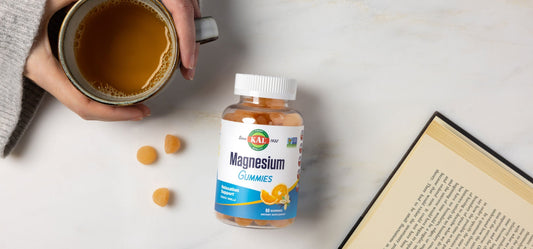Why do bones get weaker with age? It’s because your bones are living, dynamic tissue that go through a process of remodeling throughout your life, giving you a new adult skeleton about every ten years.1 In addition, not only does the human skeleton provide mobility, support, and protection, but bones are also reservoirs that store essential minerals.1
Bone mineral density refers to the strength of bones. For women, peak bone mineral density happens by the age of 20 and for men, it’s the early 20s.2 According to the American Academy of Orthopedic Surgeons, bone mass begins to decline by around age 40, however, proper nutrition and regular exercise can help slow bone loss and keep bones strong.3
Calcium Supports Bone Health
From a nutritional standpoint, calcium is key. Bone strength and structure rely on the mineral calcium, which is a major component of bone and important to bone development.4
Foods that contain calcium include dairy products such as milk, yogurt, and cheese, as well as certain vegetables like kale, broccoli, and Bok choy.5 Calcium is also added to some beverages such as fruit juices and milk substitutes.5
The average recommended daily amount of calcium is:5
| Age | Amount |
|---|---|
| 1-3 years | 700 mg |
| 4-8 years | 1,000 mg |
| 9-18 years | 1,300 mg |
| 19-70 years | 1,000 mg |
| 51-70 years (women) | 1,200 mg |
Another Rich Source of Calcium
Bone Meal Powder is available as a whole food supplement that is a rich source of calcium and phosphorus. Just 1.5 teaspoons provide 1,300 mg of calcium carbonate and 440 mg of phosphorus. It is virtually tasteless and can be easily mixed with your favorite protein drink, juice, or yogurt and can be blended into baked goods, hot cereals, and casseroles.
Adding bone meal powder to your diet each day is a great way to help support healthy bone function and density as you age.*
For more tips on nutrition, mindful wellness practices, and helping your family feel their best, follow us on Facebook @kalvits and Instagram at @kalvitamins!
*These statements have not been evaluated by the FDA. This product is not intended to diagnose, treat, cure, or prevent any disease.
References
- Office of the Surgeon General (US). Bone Health and Osteoporosis: A Report of the Surgeon General. 2004. https://www.ncbi.nlm.nih.gov/books/NBK45506/?report=reader#_NBK45506_pubdet_
- Xue S, Kemal O, Lu M, et al. Age at attainment of peak bone mineral density and its associated factors: The National Health and Nutrition Examination Survey 2005-2014. Bone. 2020. https://pubmed.ncbi.nlm.nih.gov/31760214/
- Campbell BJ. Healthy bones at every age. OrthoInfo. 2021;Aug. https://orthoinfo.aaos.org/en/staying-healthy/healthy-bones-at-every-age/
- Vannucci L, Fossi C, Quattrini S, et al. Calcium in take in bone health: a focus on calcium-rich mineral waters. Nutrients. 2018;10(12):1930. https://www.ncbi.nlm.nih.gov/pmc/articles/PMC6316542/
- National Institutes of Health Office of Dietary Supplements. Calcium fact sheet for consumers. 2023;Sept 14. https://ods.od.nih.gov/factsheets/Calcium-Consumer/




